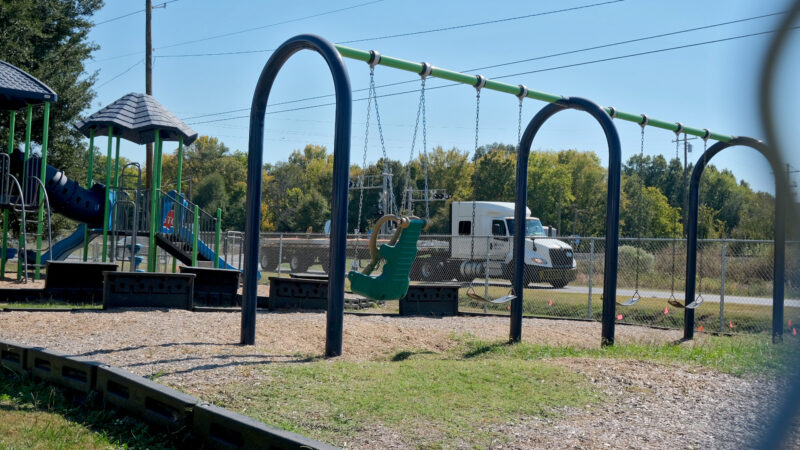Rheumatoid arthritis kept her captive. This nerve stimulator set her free.
For more than four years, Lynn Milam’s life was bound by the pain that radiated from her swollen joints.
“My children could not hug me,” she says. “I couldn’t hold my husband’s hand.”
Milam also couldn’t climb stairs or help raise her teenage son. She spent most days on the couch.
The reason was rheumatoid arthritis, which occurs when the immune system starts attacking the lining of joints.
Milam tried everything: physical therapy, acupuncture, steroids, and even the latest immune drugs. Nothing worked.
That changed in October of 2023, when a surgeon implanted an experimental device in Milam’s neck. For a minute each morning, it delivers pulses of electricity to her vagus nerve, which connects the brain with internal organs.

“Three weeks in, my elbow pain was completely gone,” she says. “Then my hands didn’t hurt anymore, the swelling started going away.”
Eventually, all symptoms of rheumatoid arthritis had vanished. Milam, 60, says she and her husband have regained the life they enjoyed before she got sick.
“It’s like a rebirth,” she says.
And now, the device will be available to many other people like Milam.
In July, the Food and Drug Administration approved the device, made by SetPoint Medical, for people with rheumatoid arthritis whose symptoms aren’t adequately controlled by drugs.
On Aug. 22, surgeons at Northwell Health in New York implanted the first approved device in a patient.

The FDA approval could be a turning point for the treatment of not only rheumatoid arthritis, but other autoimmune diseases, including multiple sclerosis and inflammatory bowel disease.
“This treatment is using the body’s own mechanism of managing inflammation,” says Dr. John Tesser, a rheumatologist in Phoenix who oversaw the study that led to the device’s approval.
By stimulating the vagus nerve, the device sends a signal to the hypothalamus, a brain area that regulates bodily functions and interacts with the immune system. That brain area responds by sending signals back down the vagus nerve to the spleen.
The signals instruct certain cells in the spleen to slow down production of proteins called cytokines, which regulate inflammation, including inflammation in the joints. Cytokines play an important role in fighting infection, but can also trigger damage to healthy tissues, including the lining of joints.
The device rarely produces the sort of dramatic recovery that Lynn Milam experienced. But the pivotal clinical trial found that patients who had not responded to even the most powerful drugs often saw meaningful improvement.
“Thirty-five percent of the patients did achieve that in this very difficult-to-treat group,” Tesser says. That was significantly more than in a comparison group whose stimulators had not yet been switched on.
The entire process is initiated by an implant “the size of a lima bean,” says Dr. Peter Konrad, chair of neurosurgery at the Rockefeller Neuroscience Institute at West Virginia University. “Everything’s all built on a little chip and then it’s contained in a little silicon jacket.”
The outpatient surgery to implant the device is straightforward for any surgeon who has implanted vagus nerve stimulators often used to control epileptic seizures, Konrad says.
“I’ve had dental surgery that was more of a process than this surgery was,” Milam says.
After the surgery, though, there was a hitch.
Because the device sits so close to the vocal chords, Milam’s voice was temporarily limited to a whisper. A second procedure fixed that, but left her voice slightly lower than it had been.
Milam says she’ll accept that for a treatment that did what drugs couldn’t.
The stimulator has restored her ability to climb stairs, cook, and travel, she says.
Her husband, Donald Milam, says it’s also allowing the couple to do things together again.
“Walking the dogs, holding hands — just the simple things,” he says. “And hugs.”
Transcript:
AILSA CHANG, HOST:
People with rheumatoid arthritis usually depend on drugs to control pain in their joints. But this summer, the Food and Drug Administration approved a different sort of treatment. It’s a device that activates the body’s own system for regulating inflammation. NPR’s Jon Hamilton reports on one of the first patients to get this device.
JON HAMILTON, BYLINE: In the summer of 2019, just after her 30th wedding anniversary, Lynn Milam’s life took a sudden turn.
LYNN MILAM: I had bent down in front of my kitchen sink and noticed this unusual pain in my knees.
HAMILTON: It was the first sign of rheumatoid arthritis, which occurs when the immune system starts attacking the lining of joints. Milam says pretty soon, everything hurt.
L MILAM: My back, my knees, my ankles, my shoulders, my neck – my whole body had become affected.
HAMILTON: Milam tried physical therapy, acupuncture, steroids and even the latest costly immune drugs. Nothing worked. Stairs were a no-go. Even a gentle touch sent pain radiating throughout her body.
L MILAM: My children could not hug me. You know, I couldn’t hold my husband’s hand.
HAMILTON: So when her rheumatologist suggested a clinical trial, Milam said yes. The trial involved a device that delivers pulses of electricity to the vagus nerve, which carries signals between the brain and internal organs. Dr. Peter Konrad, a neurosurgeon at West Virginia University, was part of a nationwide study of the device.
PETER KONRAD: It’s the size of a lima bean. I mean, that’s pretty cool when you think about an implant. It doesn’t have wires going places. Everything’s all built on a little chip, and then it’s contained in a little silicone jacket.
HAMILTON: The stimulator, made by SetPoint Medical, is placed through a small incision in the neck. Konrad says it’s a lot like devices used to control epileptic seizures.
KONRAD: Neurosurgeons have been putting vagus nerve stimulators in for epilepsy for two decades, so it’s not like we didn’t know how to put a device on the vagus nerve.
HAMILTON: For Milam, the operation itself was easy.
L MILAM: I’ve had dental surgery that was more of a process than this surgery was.
HAMILTON: There was a hitch, though. Because the device sits so close to the vocal cords, Milam’s voice was temporarily limited to a whisper. A second procedure fixed that, but left her voice slightly lower than it had been. Milam says she’ll accept that for a treatment that did what drugs could not.
L MILAM: Three weeks in, my elbow pain was completely gone. Then my hands – my hands didn’t hurt anymore, the swelling started going away. Everything started, like, going away.
HAMILTON: The idea that electrical impulses could alter the immune system was not immediately embraced by the medical community. Dr. John Tesser is a rheumatologist in Phoenix.
JOHN TESSER: I, like probably all of my colleagues, was somewhat skeptical (laughter).
HAMILTON: Then Tesser began to look at how the device works. By stimulating the vagus nerve, it activates a reflex in the brain. That reflex instructs cells in the spleen to stop making inflammatory proteins called cytokines.
TESSER: This treatment is utilizing the body’s own mechanism of managing inflammation.
HAMILTON: It rarely produces the sort of recovery that Lynn Milam experienced. But Tesser says the pivotal clinical trial found that patients who had not responded to even the most powerful drugs often saw meaningful improvement.
TESSER: Thirty-five percent of the patients did achieve that in this very difficult-to-treat group.
HAMILTON: Significantly more than in a comparison group, whose stimulators had not yet been switched on. Tesser says rheumatoid arthritis may be just the first disease treated by stimulating the vagus nerve.
TESSER: There are implications for all kinds of systemic autoimmune diseases. So we’re talking multiple sclerosis, psoriatic arthritis and inflammatory bowel disease, just to name a few.
HAMILTON: For Lynn Milam, the stimulator has restored her ability to climb stairs, cook and travel. It’s also restored a bond with her husband, Donnie, who wanted to celebrate her recovery by renewing their vows.
L MILAM: So that’s what we did. And that night, to me, meant more than our wedding. It was like a rebirth of everything.
HAMILTON: Donnie Milam says he’s just happy to be back doing everyday activities with his wife.
DONNIE MILAM: Walking the dogs, holding hands. Just the simple things. And hugs.
HAMILTON: Jon Hamilton, NPR News.
(SOUNDBITE OF SHOPAN’S “LEFT ON READ”)
Alabama Power seeks to delay rate hike for new gas plant amid outcry
The state’s largest utility has proposed delaying the rate increase from its purchase of a $622 million natural gas plant until 2028.
Former U.S. Sen. Doug Jones announces run for Alabama governor
Jones announced his campaign Monday afternoon, hours after filing campaign paperwork with the Secretary of State's Office. His gubernatorial bid could set up a rematch with U.S. Sen. Tommy Tuberville, the Republican who defeated Jones in 2020 and is now running for governor.
Scorching Saturdays: The rising heat threat inside football stadiums
Excessive heat and more frequent medical incidents in Southern college football stadiums could be a warning sign for universities across the country.
The Gulf States Newsroom is hiring an Audio Editor
The Gulf States Newsroom is hiring an Audio Editor to join our award-winning team covering important regional stories across Mississippi, Alabama and Louisiana.
Judge orders new Alabama Senate map after ruling found racial gerrymandering
U.S. District Judge Anna Manasco, appointed by President Donald Trump during his first term, issued the ruling Monday putting a new court-selected map in place for the 2026 and 2030 elections.
Construction on Meta’s largest data center brings 600% crash spike, chaos to rural Louisiana
An investigation from the Gulf States Newsroom found that trucks contracted to work at the Meta facility are causing delays and dangerous roads in Holly Ridge.









